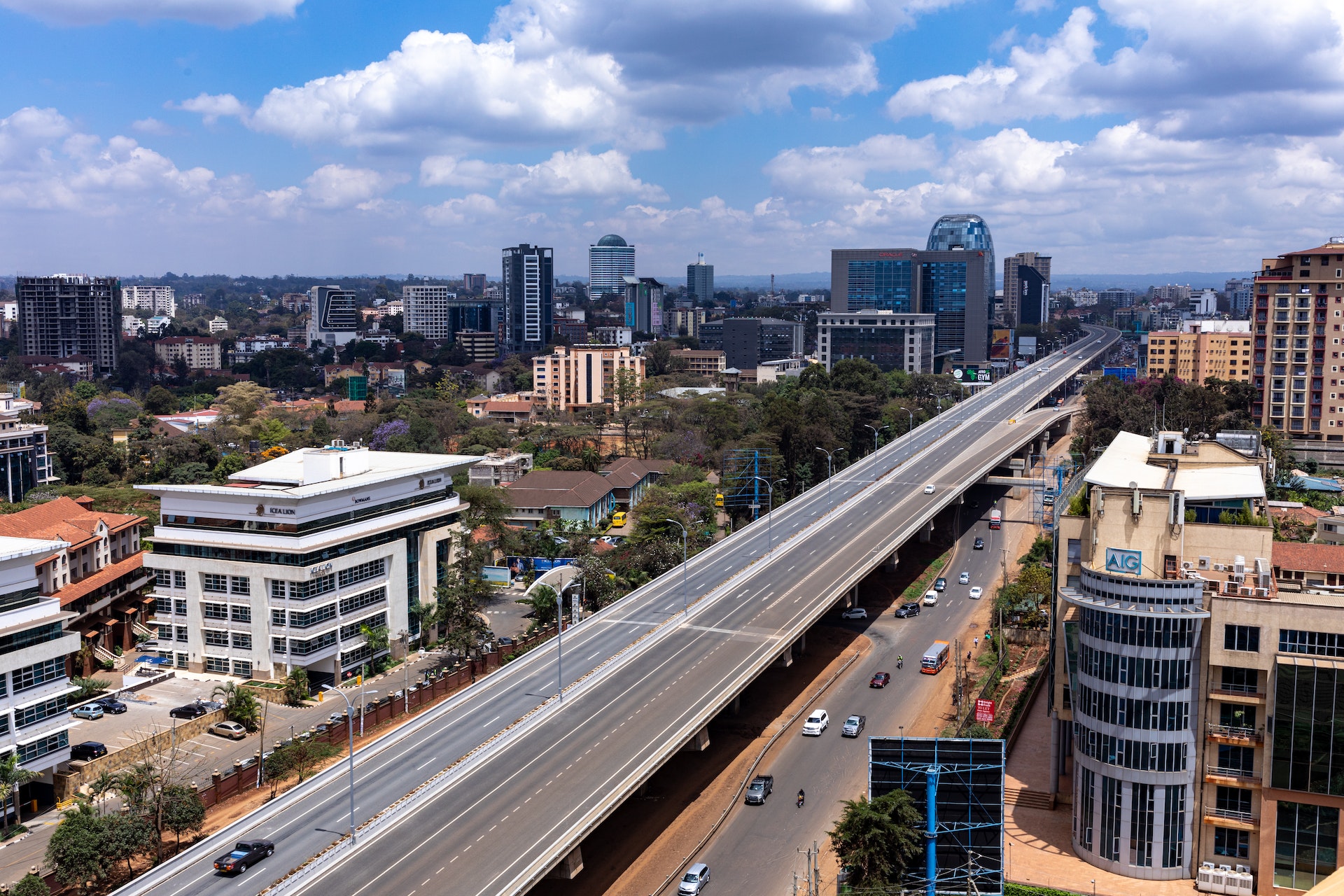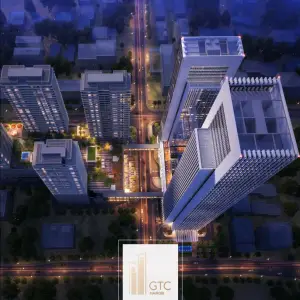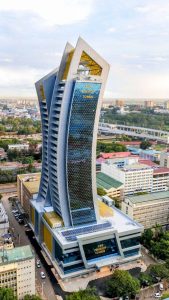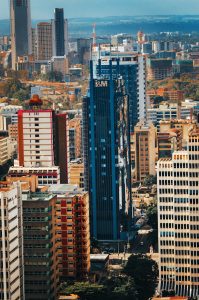Explore the Nairobi Expressway: Learn about the game-changing highway, how to use it, toll station details, and its potential impact on Nairobi’s transportation landscape and economic growth.
The Nairobi Expressway is a transformative toll highway infrastructure project, featuring an impressive configuration and a span of 27.1 km. Classified as a Class A highway, it will consist of a four-lane dual carriageway, resulting in a grand total of eight lanes.
The four lanes expands to a total of six lanes at other points. The expressway primarily links the Jomo Kenyatta International Airport to the Westlands center which is kind of the economic hub of Nairobi.
Table of Contents
Nairobi Expressway Facts
A toll highway is essentially a road where drivers are required to pay a fee in order to use the road. The fee collected are used to pay back investors and do the maintenance of the project, and The Nairobi Expressway is exactly that.
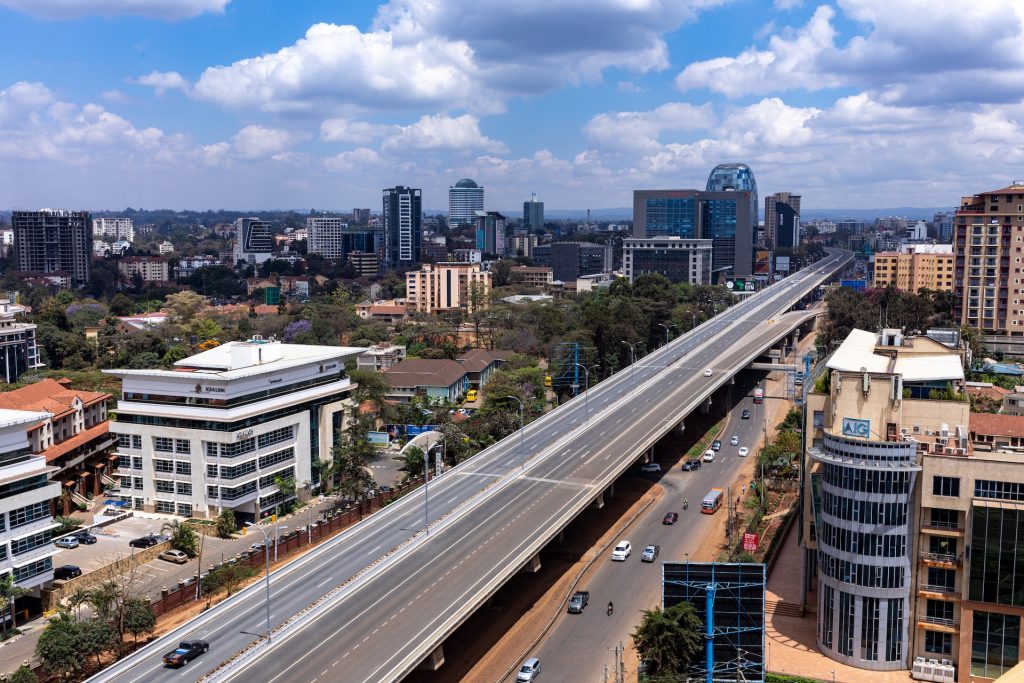
The expressway is currently owned by China Road and Bridge Corporation (CRBC), and the project operates under Build Operate Transfer (BOT) contract. This means the expressway is built, and operated by CRBC for an agreed duration so that they can recoup their investment and then later transfer the ownership to the Kenyan Government after 27 years.
Moja Expressway Company, a subsidiary of the China Road and Bridge Corporation (CRBC), has given the responsibility of managing the expressway for an extensive 27-year period. Along the route, there are a total of 11 toll stations and 27 toll plazas; that are both entrance and exit nodes.
The Kenyan government will receive ownership of the expressway in the year 2049 or early 2050. The total budget of the project was set at KSh 62 billion, but the final cost went overboard by KSh 24.8 billion, thus the total cost of the expressway was over KSh 87 billion. It is normal for mega projects to overshoot the budgets due to dynamic environment and overshadowed costs
Brief History
- In the middle of October 2019, President Uhuru Kenyatta inaugurated the Nairobi Expressway.
- Construction commenced in September of 2020.
- The provision of field tours, industrial attachments, and other work experience opportunities to students began on March 2022
- The inaugural Nairobi City Marathon took place on May 8th, 2022, along the Nairobi Expressway, drawing thousands of participants from across Kenya.
- The completed expressway was made accessible to drivers as part of a trial period, allowing for the assessment of potential enhancements. This initiative commenced on May 14th 2022.
- President Uhuru Kenyatta officially launched Kenya’s iconic Nairobi Expressway after a successful public trial on 31st July 2022
Why does Nairobi Expressway Exist?
The Nairobi Expressway was designed with the goal of relieving traffic congestion and providing seamless access to Jomo Kenyatta International Airport and its surrounding areas, particularly along the bustling Mombasa Road, and establish a direct link between Westlands and Jomo Kenyatta International Airport (JKIA). Since most people from the airport head to Westlands.
The persistent traffic jams in the Nairobi metropolitan area are estimated to result in an annual cost of Sh2 billion to the country.
It now takes 15 minutes to cruise the highway to Westlands from the airport; which is an impressive cut down from the initial 40 minutes to 2 hours on the old Mombasa Road.
Navigating The Expressway
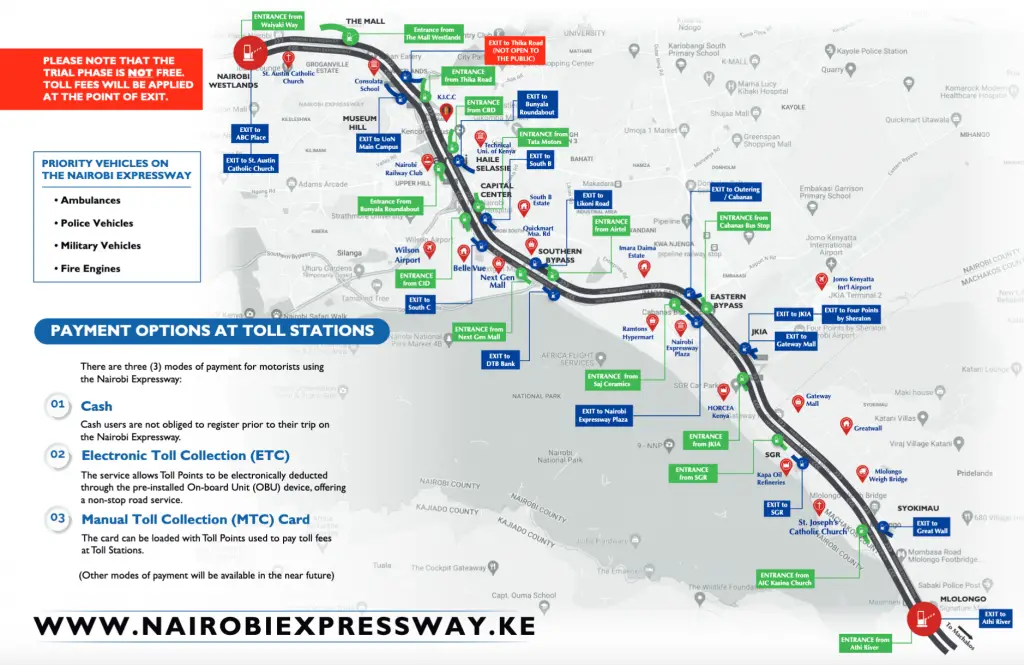
- At the start of the expressway node in Mlolongo, is a station with an entrance ramp, acceleration lane and a merging lane. Those are the three parts of entrance the expressway
- In order to utilize the road, drivers will be required to register for the Manual Toll Card (MTC) or the Electronic Toll Card (ETC) as an alternative to making payments in cash. Currently, mobile money payments are not accepted, but M-PESA is to be allowed soon
- Matatus were banned from the expressway initially, but have now been allowed back- although only a small percentage of them actually use the road anyway especially Super Metro.
- Which lane to use in expressway? Just like the normal Kenyan traffic laws, keep left always unless you are overtaking. Also, do not stop on the highway unless you are on the emergency lane on the innermost side of the road.
- Why is the expressway fenced? To primarily barrier livestock, pedestrians and non motorized traffic that can be an hazard to the cruising vehicles at the design speed. The speed limit is 80km/hr
- What to do of you miss am exit on the expressway? Use the next toll station as turns on the middle of highway are forbidden and deadly
Expressway Toll Rates
How much does it cost to use the Nairobi Expressway? Here is a table of entrances against exits. Value added tax is not included so you need to add 16% on the values.
The lowest rate is KSh 120 and the maximum us KSh 360. Note that these rates are for saloon vehicles (class 3) and may be different for other classes.
Prohibited vehicles are class 1 and class 2. Class 1 are 2 wheeled vehicles such as bicycles and motorbikes while class 2 are tuktuks. The reason they are forbidden is because they probably cant keep up with the design speed of the highway, and will be holding back traffic, tuktuks for instance are rated for 65km/hr which is lower than the highway’s 80km/hr.
Class 3 vehicles are those with two axles like; cars, SUVs, Jeeps, they pay exactly what is on the table since the conversion factor is 1X.
Class 4 vehicles are those with two axles and a high bonnet, this include some light duty trucks like Isuzu NPR, (not over 7,000Kg), and big vans. 44 seater matatus buses fall in this category. The rate in expressway chart is multiplied by a factor of 1.5. So if for the same distance a car would pay KSh 120, a matatu minibus will pay KSh 180.
Class 5 are vehicles with less 4 axles and their rate is the table value multiplied by a factor 4. These include medium duty trucks with a double differential like; Isuzu FRR
Class 6 are vehicles with 4 axles and more and the rate is a factor of 5 multiplied by the table value.
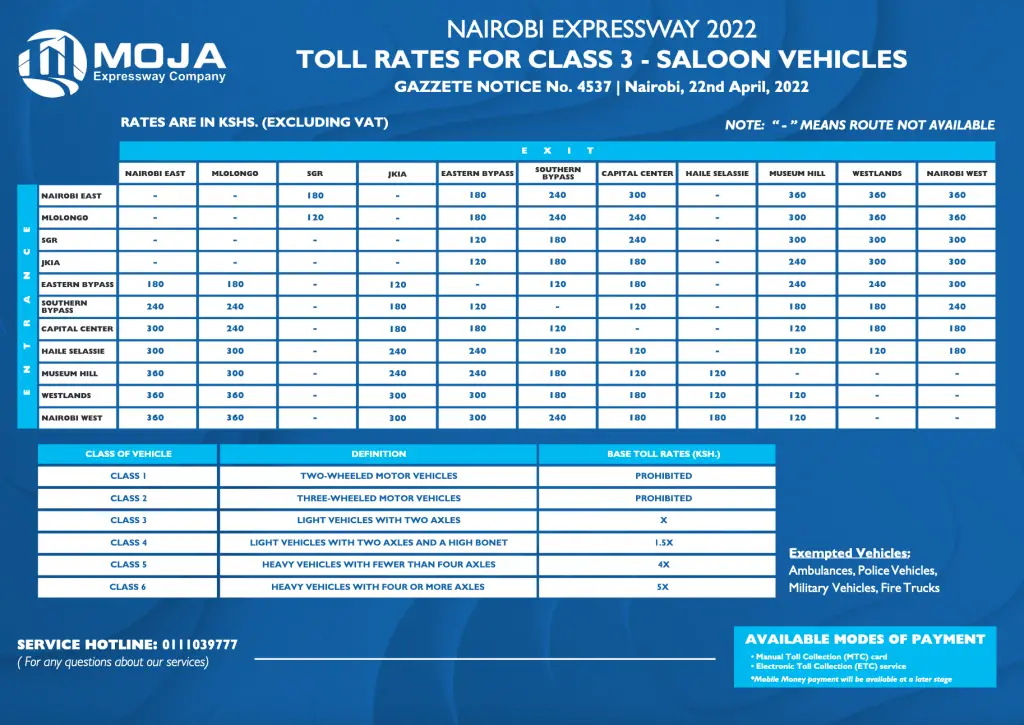
Toll Payment
Toll Payment on the Nairobi Expressway can be done via MTC, ETC or cash. MTC means Manual Toll Collection, and ETC means Electronic Toll Collection. At any entrance point, there is different entrances, separate for MTC and separate for ETC.
ETC is a technology that enables drivers to conveniently settle toll fees on highways without the need to halt their vehicle. This is achieved by placing an ETC card into the in-car ETC device. This is by far the most convenient method as vehicle don’t nee to stop at toll gates.
MTC is a car provided by the MOJA Expressway the company that runs the project. It is loaded with points that are deducted by each use of the highway. It is a non- cash method, and offers benefits such as discounts and cashback to customers sometimes. The minimum amount that can be loaded to the MTC card is KSh 1,000 and is valid for a year.
To apply for MTC card you need to visit the Nairobi Expressway Plaza and fill in a form.You will need ID or passport and KSh 300 for registration, and at-least KSh 1000 to load and activate your card for use.
ETC registration is more complex as it involves installation of an OBU( Onboard Unit) that automatically deducts toll points whenever you use the road. A registration of KSh 1,000 is required as a service charge, and then you have to load your account with a minimum of KSh 2,000 worth of toll points.
For cash payments, you have to hand it out to attendants on the toll booth.
Restrictions
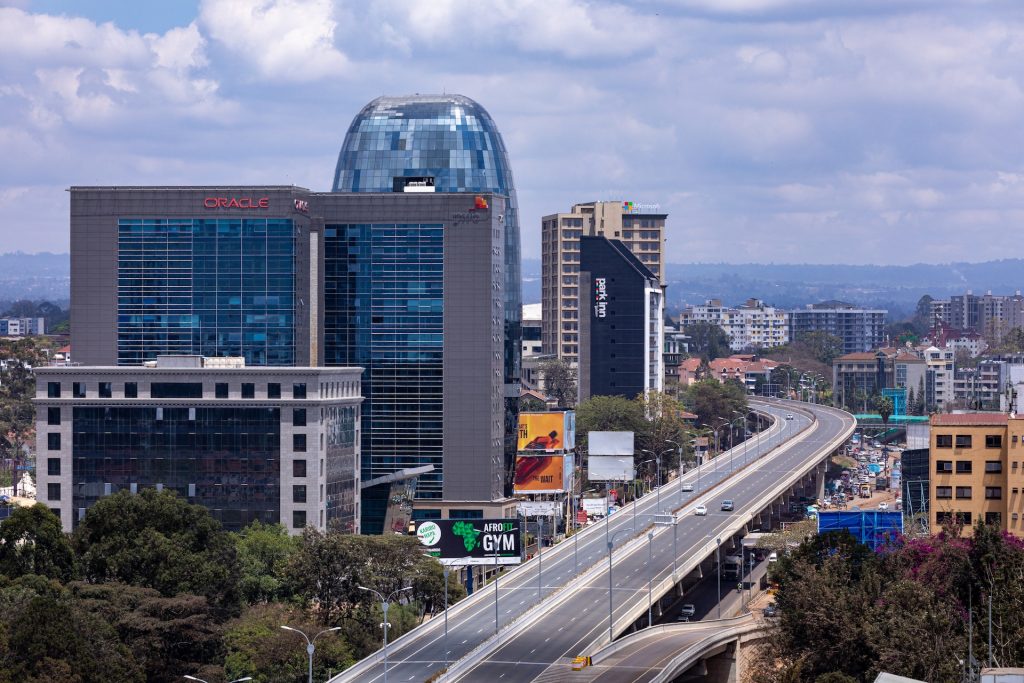
The Nairobi Expressway imposes restrictions on certain types of activities. Specifically, vehicles with fewer than four wheels, non-motorized traffic like hand carts, and pedestrians are not allowed on the expressway.
However, there is an important exception for emergency vehicles, which include ambulances, fire trucks, police vehicles, and military vehicles; these are allowed to pass through the expressway without incurring toll charges. This ensures that essential emergency services can respond swiftly and efficiently when needed.
Environmental Responsibility
Initially, the Expressway aimed to enhance environmental responsibility by reducing carbon emissions and fostering sustainable development through landscaping efforts in the median strip and on the bridge piers. Their intention was to to mitigate the loss of vegetation incurred during the construction phase by planting greenery.
However, it appears that these efforts have faced challenges, as the vegetation cover on the piers was not completed, and certain sections of the plants perished due to inadequate maintenance and lack of watering. Consequently, the project has not lived up to its initial ambition of fulfilling its environmental responsibilities.
Thoughts on the Project
What benefits does the Nairobi Expressway offer? It provides an immediate solution for alleviating traffic congestion in the short term, but it may not be the most effective long-term option. As vehicle usage and purchases persist, the expressway could eventually reach its maximum capacity.
The project also serves few percentage of Kenyans and travelers, as most of the ordinary Kenyans are still stuck on traffic snarl ups on the old roads. This projects widens the already existing social divide.
The key to addressing traffic congestion doesn’t lie in continually constructing more roads since available space is finite. We cannot endlessly expand road infrastructure forever; the actual solution lies in establishing a dependable public transportation system and making it attractive to adopt.
Relevant Links
Navigating Nairobi: Exploring Transportation Options
Ultimate Guide to Nairobi Airport: (NBO) Jomo Kenyatta-JKIA
The 15 Best Airlines Operating at JKIA Nairobi (NBO)

